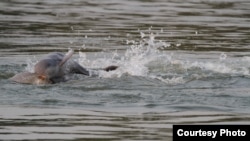Conservation experts and residents in Kratie province say they are concerned for the wellbeing of the Mekong River dolphin, especially if a major hydropower project is built upstream.
Laos says it intends to go forward with the Don Sahong Dam project, despite opposition from Cambodia and Vietnam. Meanwhile, wildlife experts say the Mekong River dolphin faces the threat of extinction.
To celebrate the third International Dolphin Day recently, the World Wide Fund for Nature and Kratie’s fisheries administration demanded a stop to the construction of Don Sahong, just two kilometers from Cambodia’s border
Chhith Sam Ath, country director of WWF in Cambodia, said the number of dolphins in the Mekong is declining already, thanks to illegal fishing, but the Don Sahong Dam poses a new threat. The damage the dam could cause outweighs its potential benefits, he said.
“First, in the construction period, they will blow up millions of tons of rock under the river to make the water flow to get hydropower,” he said. “The four dolphins that swim back and forth near the border will first get the impact and face extinction. Second, the dam will influence the fish movement and also lead to the loss of some fish. Third, we don’t know the level of water dropping down in different seasons, which could affect the habit of dolphins. Chemistry out of the dam could poison the dolphins.”
Around 400 people joined a campaign in Kratie town, shouting, “Stop the dam construction, for the sake of Mekong dolphins,” or, “To protect the dolphin is to protect the river.” Participants said the dolphins bring tourists, which benefits the local economy.
Only about 80 Mekong dolphins are estimated to now live in Cambodia, down from 200 in 1997. Many people here consider them an attraction nearly as important as the temples of Angkor Wat, in Siem Reap province.
Moung Sokleang, 58, a boat tour owner in the Kratie community of Kampi, said that everyone here earns money from the dolphins. “Therefore, I feel worried that the dolphin in the future will be lost because of the impacts of the dam.”
Mean Ngeurn, 57, a souvenir seller in Kampi, said tourists come to see dolphins, “so the profits go to our community. We should suggest stopping the dam to avoid losing the dolphin.”









